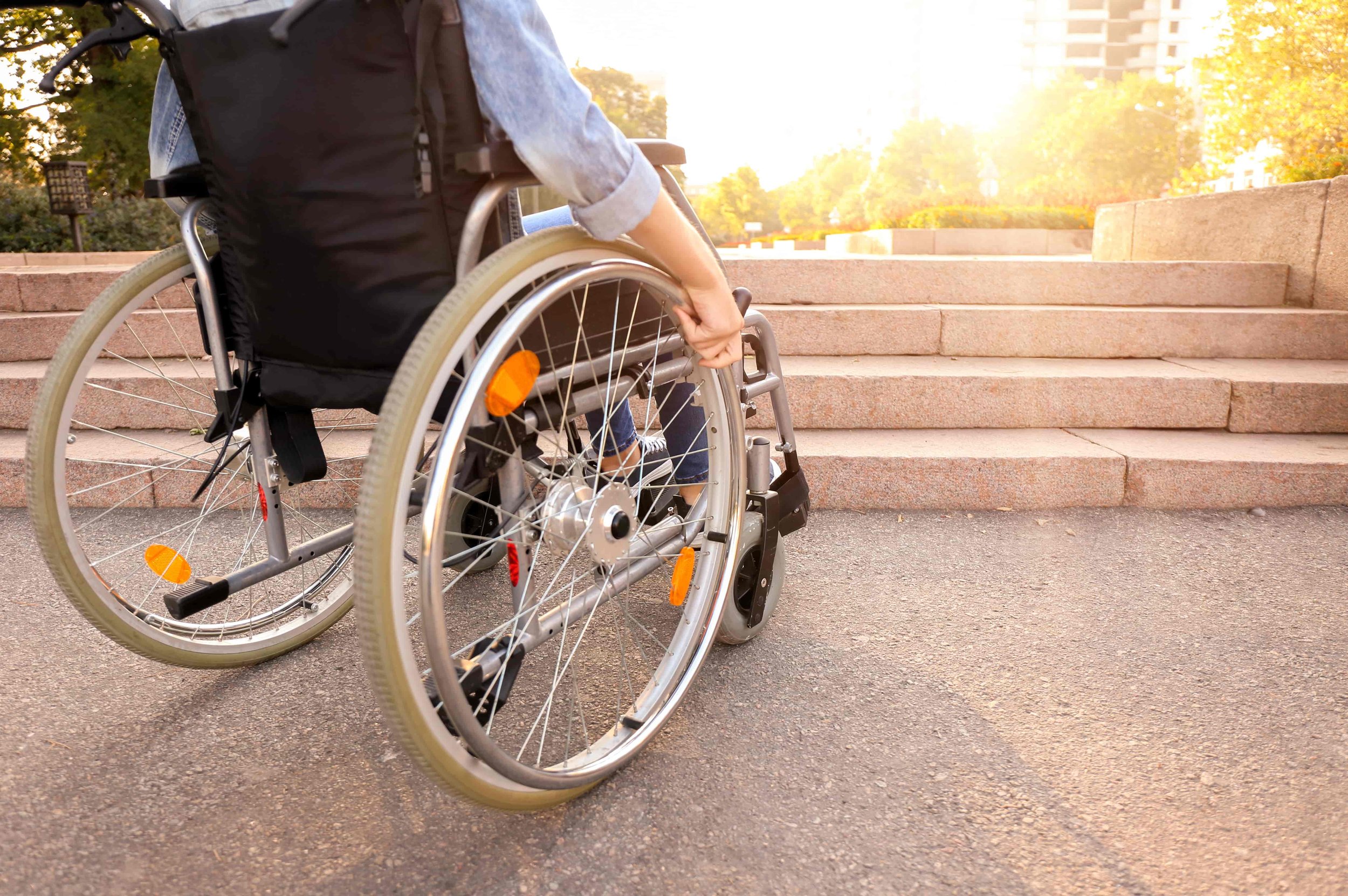Disability Access Terminology
Common Terms Used In The Field of Disability Access
There are many terms related to disability access that are misused or misunderstood. We have put together a list of these terms and defined them in layman’s terms. If you are interested in finding the official definitions of the following terms, you are advised to review the definitions of the building code that applies to your facility
Accessible
A term commonly used to identify areas and elements that meet applicable disability access requirements.
CBC Definition - A site, building, facility, or portion thereof that is approachable and usable by persons with disabilities in compliance with this code.
Accessible Route
Accessible Route is exactly what it sounds like. It is a continuous route that provides access to people with disabilities. “Accessible Route” is a term that is applied to new construction as opposed to existing facilities which would apply the term “Path of Travel”.
CBC Definition - A continuous unobstructed path connecting accessible elements and spaces of an accessible site, building or facility that can be negotiated by a person with a disability using a wheelchair and that is also safe for and usable by persons with other disabilities. Interior accessible routes may include corridors, hallways, floors, ramps, elevators and lifts. Exterior accessible routes may include parking access aisles, curb ramps, crosswalks at vehicular ways, walks, ramps and lifts.
Access Aisle
It is the area adjacent to the an accessible parking stall identified with hatched markings and a blue outline.
CBC Definition - An accessible pedestrian space adjacent to or between parking spaces that provides clearances in compliance with this code.
ADA
The acronym ADA stands for “Americans with Disabilities Act”. It is the landmark civil rights legislation that was signing into federal law in 1990 by President Bush. The term is often used interchangeably with “Accessible”. It is important to understand that the ADA is a federal law. State and local governments may have their own requirements for accessible design. For instance, if you were to ask a contractor to make an “ADA parking stall” in California, you may end up with an accessible parking stall that is ADA compliant but not “Accessible” under California’s definition.
ADA Lawsuit
An ADA lawsuit is generally used to describe a lawsuit alleging discrimination against people with disabilities. There are state and federal disability access laws that exist other than the ADA. But since the ADA is by far the most well known disability access regulation, “accessibility-related lawsuits” are often referred to as “ADA Lawsuits”.
Alteration
A significant change to a facility other than normal maintenance.
CBC Definition - A change, addition or modification in construction, change in occupancy or use, or structural repair to an existing building or facility. Alterations include, but are not limited to, remodeling, renovation, rehabilitation, reconstruction, historic restoration, resurfacing of circulation paths or vehicular ways, changes or rearrangement of the structural parts or elements, and changes or rearrangement in the plan configuration of walls and full-height partitions. Normal maintenance, re-roofing, painting or wallpapering, or changes to mechanical and electrical systems are not alterations unless they affect the usability of the building or facility.
Barriers to Accessibility
A “Barrier to Accessibility” is something that prohibits full and equal access to to people with disabilities. From an architectural standpoint, a “Barrier to Accessibility” is an element that is in non-compliance with the ADA Standards for Accessible Design. For example, a stair in front of a building entrance is a barrier to accessibility. Likewise, an exit door without the proper tactile and braille signage is also a barrier to accessibility.
Blended Transition
A sloped transition with a 5% maximum running slope between a sidewalk and a vehicular way such as a street or parking lot. Not to be confused with a “Curb Ramp” which have running slopes greater than 5%.
CBC
CBC is an acronym that stands for California Building Code (aka - Title 24). The chapters of the CBC that pertain to disability access are:
Chapter 11A - Private Multifamily Housing
Chapter 11B - Public Accommodations
Circulation Path
Any interior or exterior area where disabled or able bodied pedestrians can travel. It is not to be confused with “Accessible Route” or “Accessible Path of Travel”.
CBC Definition - An exterior or interior way of passage provided for pedestrian travel, including but not limited to, walks, sidewalks, hallways, courtyards, elevators, platform lifts, ramps, stairways, and landings.
Curb Ramp
Curb Ramps are sloped surfaces that provide access to and from a walk or sidewalk to a vehicular way such as a street or parking lot. Curb ramps have a running slope between 5% & 8.3%. Curb Ramps should not be confused with “Ramps” and “Blended Transitions”.
CBC Definition - A sloping prepared surface, intended for pedestrian traffic, which provides access between a walk or sidewalk and a surface located above or below an adjacent curb face.
Detectable Warning
One or more physical elements that can be detected by people with vision impairments or blindness. They provide a continuous boundary between safe circulation paths and hazards on a circulation path. A curb that separates a sidewalk from a street provides a detectable warning to people with vision disabilities because it can be physically detected to those without vision. However, if a Curb Ramp is provided, it would need truncated domes at the bottom of the sloped surface to provide a continuous detectable warning to separate safety from hazard.
CBC Definition - A standardized surface feature built in or applied to walking surfaces or other elements to warn persons with visual impairments of hazards on a circulation path.
Disability
An individual with a disability is defined by the ADA as a person who has a physical or mental impairment that substantially limits one or more major life activities, a person who has a history or record of such an impairment, or a person who is perceived by others as having such an impairment.
EEC
Early Evaluation Conference - Applies to owners of CASp Inspected facilities that are granted “Qualified Defendant” status.
EVCS
Electric Vehicle Charging Stations
Handicap
The terms “Handicap” & “Handicapped” are derogatory terms that are commonly used to label accessible elements or people with disabilities. Click here to read an article about why the terms are considered offensive. The origin of the term dates back to the 1500s and it is an interesting read.
Path of Travel
The term “Path of Travel” is very similar to “Accessible Route” but it applies only to existing facilities. When alterations are made to existing facilities, the term “Path of Travel” includes additional elements like restrooms, drinking fountains and signs that serve the area of planned alteration.
CBC Definition - An identifiable accessible route within an existing site, building or facility by means of which a particular area may be approached, entered and exited, and which connects a particular area with an exterior approach (including sidewalks, streets, and parking areas), an entrance to the facility, and other parts of the facility. When alterations, structural repairs or additions are made to existing buildings or facilities, the term “path of travel” also includes the toilet and bathing facilities, telephones, drinking fountains and signs serving the area of work.
Public Accommodation
A business that is open to the public.
CBC Definition - A facility operated by a private entity whose operations affect commerce and fall within at least one of the following categories –
(1) Place of lodging, except for an establishment located within a facility that contains not more than five rooms for rent or hire and that actually is occupied by the proprietor of the establishment as the residence of the proprietor. For purposes of this code, a facility is a "place of lodging" if it is
(i) An inn, hotel, or motel; or
(ii) A facility that –
(A) Provides guest rooms for sleeping for stays that primarily are short term in nature (generally 30 days or less) where the occupant does not have the right to return to a specific room or unit after the conclusion of his or her stay; and
(B) Provides guest rooms under conditions and with amenities similar to a hotel, motel, or inn, including the following –
(1) On- or off-site management and reservations service;
(2) Rooms available on a walk-up or call-in basis;
(3) Availability of housekeeping or linen service; and
(4) Acceptance of reservations for a guest room type without guaranteeing a particular unit or room until check-in, and without a prior lease or security deposit.
(2) A restaurant, bar, or other establishment serving food or drink;
(3) A motion picture house, theater, concert hall, stadium, or other place of exhibition or entertainment;
(4) An auditorium, convention center, lecture hall, or other place of public gathering;
(5) A bakery, grocery store, clothing store, hardware store, shopping center, or other sales or rental establishment;
(6) A Laundromat, dry-cleaner, bank, barber shop, beauty shop, travel service, shoe repair service, funeral parlor, gas station, office of an accountant or lawyer, pharmacy, insurance office, professional office of a health care provider, hospital, or other service establishment;
(7) A terminal, depot, or other station used for specified public transportation;
(8) A museum, library, gallery, or other place of public display or collection;
(9) A park, zoo, amusement park, or other place of recreation;
(10) A nursery, elementary, secondary, undergraduate, or postgraduate private school, or other place of education;
(11) A day care center, senior citizen center, homeless shelter, food bank, adoption agency, or other social service center establishment; and
(12) A gymnasium, health spa, bowling alley, golf course, or other place of exercise or recreation.
(13) A religious facility.
(14) An office building.
(15) A public curb or sidewalk.
Ramp
A sloped walking surface with a running slope between 5% & 8.3%. The top and bottom landings of a ramp are contained within a walk or sidewalk for pedestrian use (Not to be confused with a “Curb Ramp”).
CBC Definition - A walking surface that has a running slope steeper than one unit vertical in 20 units horizontal (5-percent slope).


